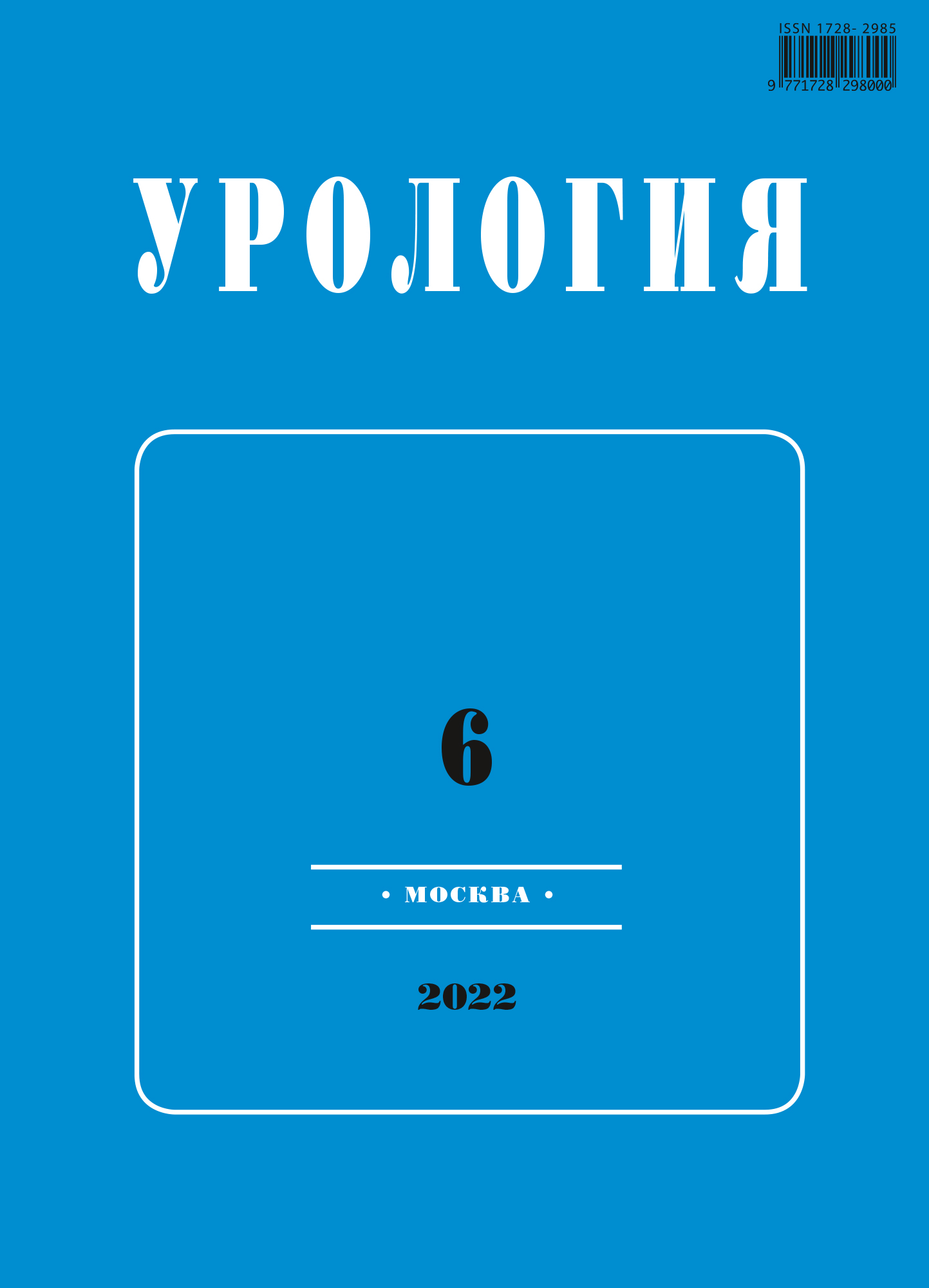Long-term safety and efficacy of trospium chloride for the treatment of neurogenic overactive bladder due to Parkinson's disease - is there an effect on cognitive status?
- 作者: Korshunova E.S1,2,3, Andreev M.N1,4, Korshunov M.N2, Pyatnitskaya T.M4, Korshunov D.M3, Darenkov S.P2, Suponeva N.A1
-
隶属关系:
- FGBNU Research Center of Neurology
- FGBU “Central state medical academy” of Administrative Directorate of the President of Russian Federation
- A.I. Evdokimov’s Moscow State University of Medicine and Dentistry
- M.V. Lomonosov’s Moscow State University
- 期: 编号 6 (2022)
- 页面: 71-77
- 栏目: Articles
- URL: https://journals.eco-vector.com/1728-2985/article/view/277151
- DOI: https://doi.org/10.18565/urology.2022.6.71-77
- ID: 277151
如何引用文章
详细
全文:
作者简介
E. Korshunova
FGBNU Research Center of Neurology; FGBU “Central state medical academy” of Administrative Directorate of the President of Russian Federation; A.I. Evdokimov’s Moscow State University of Medicine and Dentistry
Email: e_korshunova@mail.ru
Ph.D., associate professor Moscow, Russia; Moscow, Russia
M. Andreev
FGBNU Research Center of Neurology; M.V. Lomonosov’s Moscow State Universityneurologist; Ph.D. student of the Faculty of Fundamental Medicine Moscow, Russia
M. Korshunov
FGBU “Central state medical academy” of Administrative Directorate of the President of Russian FederationPhD, associate professor Moscow, Russia
T. Pyatnitskaya
M.V. Lomonosov’s Moscow State University
Email: tomapyatnitskaya@gmail.com
student Moscow, Russia
D. Korshunov
A.I. Evdokimov’s Moscow State University of Medicine and Dentistrystudent Moscow, Russia
S. Darenkov
FGBU “Central state medical academy” of Administrative Directorate of the President of Russian FederationPh.D., MD, Professor, Head of the Department of Urology Moscow, Russia
N. Suponeva
FGBNU Research Center of NeurologyPh.D., MD, Professor, Corresponding member of Russian Academy of Sciences, Director of the Institute of Neurorehabilitation Moscow, Russia
参考
- https://www.who.int/ru/news-room/fact-sheets/detail/parkinson-disease
- Sakakibara R., Panicker J., Finazzi-Agro E., Iacovelli V., & Bruschini H.(2015). A guideline for the management of bladder dysfunction in Parkinson’s disease and other gait disorders. Neurourology and Urodynamics, 35(5), 551-563. doi: 10.1002/nau.22764.
- Мазуренко Е.В., Пономарев В.В., Сакович Р.А. Когнитивные нарушения при болезни Паркинсона. Медицинские новости. 2014;1:6-11.
- https://cr.minzdrav.gov.ru/recomend/588_2
- Bell B., Avery A., Bishara D., Coupland C., Ashcroft D., Orrell M. Anticholinergic drugs and risk of dementia: Time for action? Pharmacol Res Perspect. 2021;9(3):e00793. doi: 10.1002/prp2.793. PMID: 34087056; PMCID: PMC8177062.
- https://www.rlsnet.ru
- Alka A. Bhide,Visha Tailor, Ruwan Fernando, Vik Khullar, Giuseppe Alessandro Digesu. Posteriortibial nerve stimulation for overactive bladder -techniques and efficacy.Int Urogynecol J. 2020;31(5):865-870. doi: 10.1007/s00192-019-04186-3
- Филиппова Е.С., Баженов И.В., Зырянов А.В., Борзунов И.В., Москвина Е.Ю., Морозова А.А., Буксман А.И. Оценка качества жизни, связанного с нарушениями мочеиспускания, у больных рассеянным склерозом: перевод и валидизация русскоязычной версии опросника SF-Qualiveen. Уральский медицинский журнал. 2019;3:39-43. https://doi.org/10.25694/URMJ.2019.03.19
- Ziad S. Nasreddine, Natalie A. Phillips, Valerie Bedirian, Simon Charbonneau, Victor Whitehead.The Montreal Cognitive Assessment, MoCA: A Brief Screening Tool For Mild Cognitive Impairment. J Am Geriatrics Soc. 2005;53(4):695-699. doi: 10.1111/j.1532-5415.2005.53221.x
- Herschorn S., Stothers L., Carlson K., Egerdie B., Gajewski J.B., Pommerville P., Schulz J., Radomski S., Drutz H., Barkin J, Paradiso-Hardy F. Tolerability of 5 mg solifenacin once daily versus 5 mg oxybutynin immediate release 3 times daily: results of the VECTOR trial. J Urol. 2010;183(5):1892-1898. doi: 10.1016/j.juro.2010.01.012.
- Guay D.R.P. Clinical pharmacokinetics of drugs used to treat urge incontinence. Clin Pharmacokinet. 2003;42:1243-1285. doi: 10.2165/00003088-200342140-00004
- Ohtake A., Saitoh C., Yuyama H. Pharmacological characterization of a new antimuscarinic agent, solifenacin succinate, in comparison with other antimuscarinic agents. Biol Pharm Bull.2007;30:54-58. doi: 10.1248/bpb.30.54.
- Chapple C.R., Khullar V., Gabriel Z. The effects of antimuscarinic treatments in overactive bladder: an update of a systematic review and meta-analysis. Eur Urol. 2008;54:543-562. doi: 10.1016/j.eururo.2008.06.047
- Ortiz de Montellano, Paul R. Cytochrome P450: structure, mechanism, and biochemistry. 3rd edition. New York: Kluwer Academic/Plenum Publishers, 2005. ISBN 0-306-48324-6
- Callegari E., Malhotra B., Bungay P.J., Webster R., Fenner K.S., Kempshall S., LaPerle J.L., Michel M.C., Kay G. A comprehensive non-clinical evaluation of the CNS pene.tration potential of antimuscarinic agents for the treatment of overactive bladder. Br J Clin Pharmacol. 2011;72(2):235-246. doi: 10.1111/j.1365-2125.2011.03961.x.
- Коршунова Е.С., Коршунов М.Н. Гиперактивный мочевой пузырь у мольтиморбидных больных. Что нужно помнить? Consilium Medicum. 2018;20(7):41-45). doi: 10.26442/2075-1753_2018.7.41-45.
- Gray S.L., et al. Cumulative use of strong anticholinergics and incident dementia: a prospective cohort study. JAMA Intern Med. 2015;175:401. doi: 10.1001/jamainternmed.2014.7663
- Risacher S.L., et al. Association between anticholinergic medication use and cognition, brain metabolism, and brain atrophy in cognitively normal older adults. JAMA Neurology, 2016.73:721. doi: 10.1001/jamaneurol.2016.0580.
- Jumadilova Z., et al. Retrospective evaluation of outcomes in patients with overactive bladder receiving tolterodine versus oxybutynin. Am J Health Syst Pharm, 2006;63:2357. doi: 10.2146/ajhp060038
- Staskin D, Kay G, Tannenbaum C, Goldman HB, Bhashi K, Ling J, Oefelein MG.Trospium Chloride Has No Effect on Memory Testing and Is Assay Undetectable in the Central Nervous System of Older Patients with Overactive Bladder.Int J Clin Pract 2010;64:1294-300. doi: 10.1111/j.1742-1241.2010.02433.x
- Araklitis G, Robinson D, Cardozo L. Cognitive Effects of Anticholinergic Load in Women with Overactive Bladder. Clinical Interventions in Aging. 2020;15:1493-1503. doi: 10.2147/CIA.S252852
- Ivchenko A., Bödeker RH., Neumeister C. et al. Anticholinergic burden and comorbidities in patients attending treatment with trospium chloride for overactive bladder in a real-life setting: results of a prospective noninterventional study. BMC Urol 2018; 18:80. doi.org/10.1186/s12894-018-0394-8
- Anthony G. Visco, Linda Brubaker, Holly E. Richter, Ingrid Nygaard, Marie Fidela R. Paraiso, Shawn A. Menefee, Joseph Schaffer, Jerry Lowder, Salil Khandwala, Larry Sirls, Cathie Spino, Tracy L. Nolen, Dennis Wallace, Susan F. Meikle. Anticholinergic Therapy vs. Onabotulinumtoxin A for Urgency Urinary Incontinence. N Engl J Med. 2012;367(19):1803-13. doi: 10.1056/NEJMoa1208872.
- Non-dopamine Lesions in Parkinson’s Disease. Ed. G Halliday, R Barker, D Rowe. Oxford University Press; 2011, Cersosimo MG, Benarroch EE. Neural control of the gastrointestinal tract: implications for Parkinson’s disease. Mov Disord. 2008;23:1065-1075
补充文件







